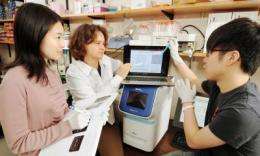Study identifies mechanisms cells use to remove bits of RNA from DNA strands

When RNA component units called ribonucleotides become embedded in genomic DNA, which contains the complete genetic data for an organism, they can cause problems for cells. It is known that ribonucleotides in DNA can potentially distort the DNA double helix, resulting in genomic instability and altered DNA metabolism, but not much is known about the fate of these ribonucleotides.
A new study provides a mechanistic explanation of how ribonucleotides embedded in genomic DNA are recognized and removed from cells. Two mechanisms, enzymes called ribonucleases (RNases) H and the DNA mismatch repair system, appear to interplay to root out the RNA components.
"We believe this is the first study to show that cells utilize independent repair pathways to remove mispaired ribonucleotides embedded in chromosomal DNA, which can be sources of genetic modification if not removed," said Francesca Storici, an assistant professor in the School of Biology at the Georgia Institute of Technology. "The results also highlight a novel case of genetic redundancy, where the mismatch repair system and RNase H mechanisms compete with each other to remove misincorporated ribonucleotides and restore DNA integrity."
The findings were reported Dec. 4, 2011 in the advance online publication of the journal Nature Structural & Molecular Biology. The research was supported by the Georgia Cancer Coalition, National Science Foundation and Georgia Tech Integrative BioSystems Institute.
Storici and Georgia Tech biology graduate students Ying Shen and Kyung Duk Koh conducted the study in collaboration with Bernard Weiss, a professor emeritus in the Department of Pathology and Laboratory Medicine at Emory University.
"We wanted to understand how cells of the bacterium Escherichia coli and the yeast Saccharomyces cerevisiae tolerate the presence of different ribonucleotides embedded in their genomic DNA. We found that the structure of a ribonucleotide tract embedded in DNA influenced its ability to cause genetic mutations more than the tract's length," said Storici.
With double-stranded DNA, when wrong bases are paired or one or few nucleotides are in excess or missing on one of the strands, a mismatch is generated. If mismatches are not corrected, they can lead to mutations.
The researchers found that single mismatched ribonucleotides in chromosomal DNA were removed by either the mismatch repair system or RNase H type 2. Mismatched ribonucleotides in the middle of at least four other ribonucleotides required RNase H type 1 for removal.
"We were excited to find that a DNA repair mechanism like mismatch repair was activated by RNA/DNA mismatches and could remove ribonucleotides embedded in chromosomal DNA," explained Storici. "In future studies, we plan to test whether other DNA repair mechanisms, such as nucleotide-excision repair and base-excision repair, can also locate and remove ribonucleotides in DNA."
Using gene correction assays driven by short nucleic acid polymers called oligonucleotides, the researchers showed that when ribonucleotides embedded in DNA were not removed, they served as templates for DNA synthesis and produced a mutation in the DNA. If both the mismatch repair system and RNase H repair mechanisms are disabled, ribonucleotide-driven gene modification increased by a factor of 47 in the yeast and 77,000 in the bacterium.
Defects in the mismatch repair system are known to predispose a person to certain types of cancer. Because the mismatch repair system is conserved from unicellular to multicellular organisms, such as humans, this study's findings open up the possibility that defects in the mismatch repair system could have consequences more critical than previously thought given the newly identified function of mismatch repair to target RNA/DNA mispairs.














